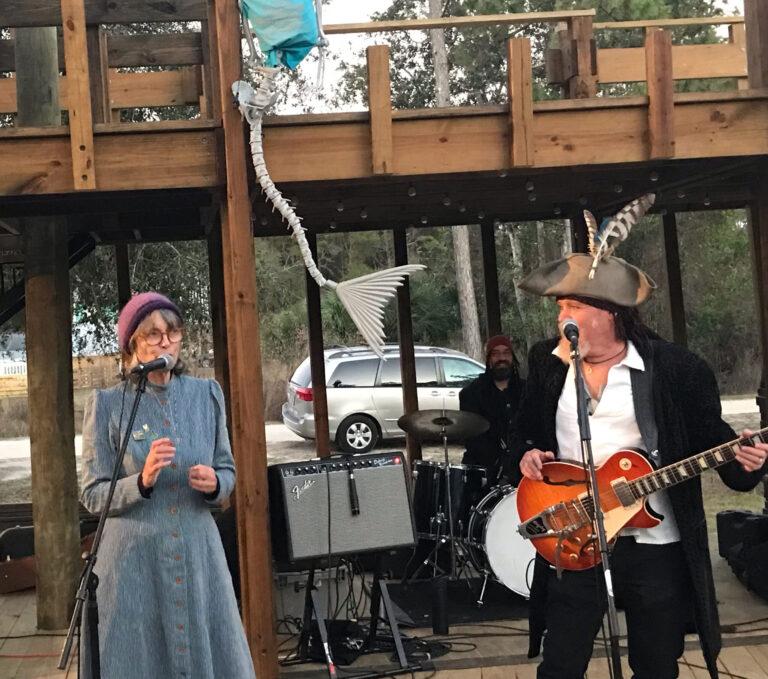Legacy Post Disclaimer
This is a #Legacy post imported from The Apalachicola Time’s previous platform. If you’re experiencing issues with this article, please email us at news@nevespublishing.com.
HCA reopens with Maroon Marines exhibit
After more than two years in which the Apalachicola Center for History, Cultural and the Arts remained mainly closed, vacated by the pandemic, the HCA reopened last week with the cutting of a ribbon, the sharing in a party and the exhibiting of aspects of Black history, culture and arts.
The primary one focuses on the most dramatic and tragic episode in the early 19th century of what was formally the Fort Gadsden Historic Site, now known as the Prospect Bluff Historic Site, on the Apalachicola River, about six miles southwest of Sumatra.
A second one features the most recent Chinese brush paintings of Florida A & M University arts professor Nan Liu, part of a series of life-sized FAMU student figurative paintings with oil and ink medium, that work to capture the moments that make up students’ lives on campus.
A third section of the center’s first floor, and the most immediately local, presents the first of a collection of black-and-white photographs, dating back to the late 1800s of the Hill community, including family portraits, and the graduating classes of Quinn High School from 1963 and 1967.
Representatives of the local non-profit, North Florida African-American Corridor Project, Inc., recently granted a one-year lease by the city to manage the HCA, cut a large blue ribbon that commemorated the new era.
Holding the Apalachicola Chamber of Commerce’s enormous scissors, Willie Tolliver spoke on behalf of the NFAACP, standing alongside Apalachicola resident Myrtis Wynn, an early local visionary of the project and who now chairs the HCA board. Board members also include Cornelius Abner, Erica Ball, Harold Banks, Dolores Croom, Marzetta Davis, Chauncey Ford, Falan Goff, Alfred Goosby, Dorothy Goosby, Marcia Smith and Ocea Wynn..
A retired social work professor who now lives full-time in Apalachicola, where he was born and raised, Tolliver paid tribute to the project’s founders, as well as the four generations in Apalachicola family that preceded him, as far back as slavery. The formal name of the HCA building, the Harrison-Raney Cotton Warehouse, built in 1836, was instrumental to the cotton trade, and Tolliver alluded, without emphasis or detail, to that history.
His words celebrated the joy of the moment, and the promising future that the HCA has as it returns to a full schedule.
No sooner had the ribbon’s severed ends fluttered to the pavement, the Thursday evening, Nov. 17 audience filed into the building to hear a presentation by archaeology professor Mike Thomin, from the University of West Florida, on the Maroon Marines.
Thomin’s talk covered the the history of Prospect Bluff, the so-called Negro Fort, which is told in the HCA exhibit. The fort has gotten increased attention from historians in recent years, as more details of that community of Indians and fugitive slaves have been unearthed, beyond the most notable detail when a party during the War of 1812 led by Gen. Andrew Jackson attacked the fort, and killed nearly all of its residents with an errant cannon ball that hit the ammunition supply.
Thomin’s talk shared details of the people who lived at the fort, who survived and made their way to the Caribbean, or to other parts of the Panhandle, where in some cases they were returned to slavery now that they were no longer under the command of the British, who had outlawed the slave trade in 1807 and who would abolish the institution in 1833.
The exhibit, by Thomin and Nicole Grinnan with the University of West Florida and Florida Public Archaeology Network, is on display until the end of February.
Running until the end of the year is an exhibit of 16 paintings of Nan Liu, a Chinese-born and educated professor who emigrated to the US. in 1999. He has taught art at Florida A&M University for the past 10 years and his widely-acclaimed works have been exhibited across the United States and in the homes of private patrons.




Meet the Editor
David Adlerstein, The Apalachicola Times’ digital editor, started with the news outlet in January 2002 as a reporter.
Prior to then, David Adlerstein began as a newspaperman with a small Boston weekly, after graduating magna cum laude from Brandeis University in Waltham, Massachusetts. He later edited the weekly Bellville Times, and as business reporter for the daily Marion Star, both not far from his hometown of Columbus, Ohio.
In 1995, he moved to South Florida, and worked as a business reporter and editor of Medical Business newspaper. In Jan. 2002, he began with the Apalachicola Times, first as reporter and later as editor, and in Oct. 2020, also began editing the Port St. Joe Star.